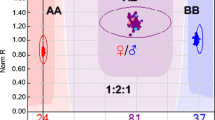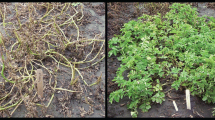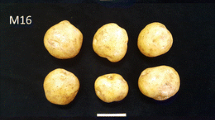Abstract
The major potato of commerce,Solanum tuberosum L., is the fourth most important food crop in the world after rice, wheat and corn. Fortunately, the potato has many primitive cultivars and wild species relatives useful to reduce our reliance on chemical controls. These include resistances against diseases, pests, and traits for useful agronomic characters such as yield, specific gravity, chipping qualities, and suppression of enzymatic browning. This paper summarizes some of these qualities, and provides an overview of germplasm availability and taxonomy of the wild species.
The major potato of commerce,Solanum tuberosum L., is the fourth most important food crop in the world after rice, wheat and maize. It is grown in more countries than any other crop but maize, and forms the staple crop of many societies. Over 280 million metric tons were grown worldwide in 1989, with Eastern Europe growing 46%, Asia 22%, Western Europe 17%, North America 7%, Latin America 5%, and Africa 3% (2). It is the leading vegetable crop in acreage and farm value in the United States, with 1.2 million acres planted in 1991, with a value of sales almost two and one-half billion dollars (53).Solanum tuberosum is one species of a group of seven cultivated and 216 additional tuber-bearing, and nine non-tuber-bearing wild relatives, all classified by Hawkes (41) in the genusSolanum, sectionPetota Dumort
The purposes of this paper are threefold: 1) to provide examples of the proven and potential utility of wild and cultivated landrace members of sect.Petota for reducing our reliance on chemical controls for many pests and diseases that affect commercial cultivars, 2) to provide an overview of the status of germplasm availability of these species, and 3) to highlight the benefits for continuing germplasm collections and systematic studies of the group.
Compendio
Solanum tuberosum L., la principal papa en el mercado, es el cuarto cultivo alimenticio más importante en el mundo, después del arroz, del trigo y del maíz. Afortunadamente, la papa tiene muchos cultivares primitivos y especies silvestres relacionadas útiles para reducir nuestra dependencia en los controles químicos. Estos incluyen resistencias contra enfermedades y plagas, así como también útiles características agronómicas tales como rendimiento, gravedad específica, calidades para fritura a la inglesa y supresión del pardeamiento enzimático. Este artículo resume algunas de estas cualidades y provee una vision del germoplasma disponible y de la taxonomía de las especies silvestres.
Similar content being viewed by others
Literature Cited
Anon. 1959. The long range program of the Inter Regional Potato Introduction and Preservation Project (IR-1): a policy statement. Am Potato J 36:457–460.
Anon. 1991. CIP Circular 18(3), 11 pp.
Austin, S., M.K. Ehlenfeldt, M.A. Baer and J.P. Helgeson. 1986. Somatic hybrids produced by protoplast fusion betweenS. tuberosum andS. brevidens: phenotypic variation under field conditions. Theor Appl Genet 71:682–690.
Austin, S., E. Lojkowska, M.K. Ehlenfeldt, A. Kelman and J.P. Helgeson. 1988. Fertile interspecific somatic hybrids ofSolarium: a novel source of resistance toErwinia soft rot. Phytopathology 78:1216–1220.
Bishop, B.A. and E. Grafius. 1991. An on-farm insecticide resistance test kit for Colorado potato beetle (Coleoptera: chrysomelidae). Am Potato J 68:53–64.
Brodie, B.B., R.L. Plaisted and M.M. de Scurrah. 1991. The incorporation of resistance toGlobodera pallida intoSolanum tuberosum germplasm adapted to North America. Am Potato J 68:1–11.
Brown, C.R., H. Mojtahedi and G.S. Santo. 1991. Resistance to Columbia root-knot nematode inSolanum ssp. and in hybrids ofS. Hougasii with tetraploid cultivated potato. Am Potato J 68:445–452.
Bukasov, S.M. 1978. Systematics of the potato.In: Kameraz, A.Y. (Ed.), Dhote, A.K. (Trans lator). Systematics, breeding and seed production of potatoes. Amerind Publishing Company, New Delhi (English translation of article first appearing in Trudy Prikl Bot 62). pp. 1–69.
Chet, I. (Ed.). 1993. Biotechnology in plant disease control. Wiley-Liff, New York. 373 pp.
Child, A. 1990. A synopsis ofSolanum subgenusPotatoe (G. Don) (D’Arcy) (Tuberarium (Dun.) Bitter (s.l.)). Feddes Repert 101: 209–235.
Contreras-M., A., 1987. Germoplasma chileno de papas (Solanum spp.). An Simp Rec Fitogenéticos, Valdivia [Chile] 1984. Univ Austral Chile and Int Board PI Genet Resources. 75 pp.
Correll, D.S. 1952. SectionTuberarium of the genusSolanum of North and Central America, USDA Agric Monogr 11:1–243.
Correll, D.S. 1962. The potato and its wild relatives. Contrib Texas Res Found Bot Stud 4:1–606.
Correll, D.S. 1967. Flora of Peru: Solanaceae, sectionNeolycopersicon andsection Tuberarium. Field Mus Nat Hist Publ Bot Ser 13: 271–458.
Corsini, D.L., J.J. Pavek and J.R. Davis. 1988. Verticillium wilt resistance in noncultivated tuber-bearingSolanum species. Plant Dis 72:148–151.
Corsini, D.L., J.J. Pavek and J.R. Davis. 1990. Verticillium wilt resistant potato germplasm: A66107-51 and A68113-4. Am Potato J 67:517–525.
D’Arcy, W.G. 1972. Solanaceae studies II: typification of subdivisions ofSolanum. Ann Missouri Bot Gard 59:262–278.
D’Arcy, W.G. 1991. The Solanaceae since 1976, with a review of its biogeography.In: Hawkes, J.G., Lester, R.N., Nee, M., Estrada, R.N. [Eds.]. Solanaceae III: taxonomy, chemistry, evolution. Royal Botanic Gardens, Kew, England. pp. 75–137.
Davis, J.M., W.H. Loescher, M.W. Hammond and R.E. Thorton. 1986. Response of Russet Burbank potatoes to soil fumigation and nitrogen fertilizers. Am Potato J 63:71–79.
Davis, J.R. 1985. Approaches to control of potato early dying caused byVerticillium dahliae. Am Potato J 62:177–185.
Davis, J.R. L.H. Sorensen, J.C. Stark and D.T. Westermann. 1990. Fertility and management practices to control Verticillium wilt of the Russet Burbank potato. Am Potato J 67:55–65.
Deahl, K.L., W.W. Cantelo, S.L. Sinden and L.L. Sanford. 1991a. The effect of light intensity on Colorado potato beetle resistance and foliar glycoalkaloid concentration of fourSolanum chacoense clones. Am Potato J 68:659–666.
Deahl, K.L., R.W. Goth, R. Young, S.L. Sinden and M.E. Gallegly. 1991b. Occurrence of the A2 mating type ofPhytophthora infestans in potato fields in the United States and Canada. Am Potato J 68:717–725.
Duchesne, R.M. and J.G. Parent. 1991. The flowering tobacco as a new alternative host for the Colorado potato beetle. Am Potato J 68:743–750.
Easton, G.D. M.E. Nagle and M.D. Seymour. 1992. Potato production and incidence ofVerticillium dahliae following rotation to nonhost crops and soil fumigation in the state of Washington. Am Potato J 69:489–502.
Ehlenfeldt, M.K. and R.E. Hanneman, Jr. 1984. The use of Endosperm Balance Number and 2n gametes to transfer exotic germplasm in potato. Theor Appl Genet 68:155–161.
Evans, K. and B.B. Brodie. 1980. The origin and distribution of the golden nematode and its potential in the U.S.A. Am Potato J 57:79–89.
Flanders, K.L., J.G. Hawkes, E.B. Radcliffe and F.I. Lauer. 1992. Insect resistance in potatoes: sources, evolutionary relationships, morphological and chemical defenses, and ecogeographical associations. Euphytica 61:83–111.
Flores-C., R. 1966. Estudio preliminar del generoSolanum, seccionTuberarium subseccionHyperbasarthrum en México. Undergraduate Thesis, Univ Nac Autónoma de México, México, D. F. 100 pp.
Fold/, N.E. 1987. Genetic resources—their preservation and utilization.In: Jellis, G.J., Richardson, D.E. (Eds.). The production of new potato varieties: technological advances. Cambridge Univ Press, Cambridge. pp. 10–27.
Gorbatenko, L.E., 1989. Systematic conspectus of sectionPetota Dumort. of the genusSolanum L. in South America. [In Russian]. Trudy Prikl Bot 126: 92–108.
Hanneman, R.E., Jr. 1989. The potato germplasm resource. Am Potato J 66:655–667.
Hanneman, R.E., Jr. and J.B. Bamberg. 1986. Inventory of tuber-bearingSolanum species. Wis Agric Exp Sta Bull 533:1–216.
Harlan, J.R. and J.M.J. de Wet. 1971. Toward a rational classification of cultivated plants. Taxon 20:509–517.
Harper, F.R., G.A. Nelson and U.J. Pittman. 1975. Relationship between leaf roll symptoms and yield in Netted Gem potato. Phytopathology 65:1242–1244.
Hawkes, J.G. 1944. Potato collecting expeditions in Mexico and South America. II. Systematic classification of the collections. Imp Bur PI Breed Genet, Imp Agric Bur, Cambridge. 142 pp.
Hawkes, J.G. 1966. Modern taxonomic work on theSolanum species of Mexico and adjacent countries. Am Potato J 43: 81–103.
Hawkes, J.G. 1977. The importance of wild germplasm in plant breeding. Euphytica 26:615–621.
Hawkes, J.G. 1980. The taxonomy of cultivated plants and its importance in plant breeding research.In: Perspectives in world agriculture, Commonwealth Agricultural Bureaux, Farnham, England. pp. 49–66.
Hawkes, J.G. 1986. Problems of taxonomy and nomenclature in cultivated plants. Acta Hortic (Wageningen) 182:41–52.
Hawkes, J.G. 1990. The potato: evolution, biodiversity and genetic resources. Belhaven Press, Oxford, England. 259 pp.
Hawkes, J.G. and J.P. Hjerting. 1969. The potatoes of Argentina, Brazil, Paraguay, and Uruguay: a biosystematic study. Ann Bot Mem 3:1–525+150 pl.
Hawkes, J.G. and J.P. Hjerting. 1989. The potatoes of Bolivia: their breeding value and evolutionary relationships. Oxford University Press, Oxford. 472 pp.
Hermsen, J.G.Th. 1989. Current use of potato collections.In: Brown, A.H.D., Frankel, O.H., Marshall, D.R., Williams, J.T. (Eds.). The use of plant genetic resources. Cambridge Univ Press, Cambridge, England. pp. 68–87.
Hermundstad, S. and S.J. Peloquin. 1986. Tuber yield and tuber traits of haploid-wild F1 species hybrids. Potato Res 29:287–297.
Hougas, R.W. and F.A. Krantz. 1953. Inter-regional potato introduction project. Am Potato J 30:295–297.
Hoyos, G.P., P.J. Zambino and N.A. Anderson. 1991. An assay to quantify vascular colonization of potato byVerticillium dahliae. Am Potato J 68:727–742.
Iwanaga, M. and P. Schmiediche. 1989. Using wild species to improve potato cultivars. CIP circular 17(2):1–7.
Joaquim, T.R., V.L Smith and R.C. Rowe. 1988. Seasonal variation and effects of wheat rotation on populations ofVerticillium dahliae Kleb. in Ohio potato fields. Am Potato J 65:439–447.
Johnston, R.L. and L.E. Sandvol. 1986. Susceptibility of Idaho populations of Colorado potato beetle to four classes of insecticides. Am Potato J 63:81–85.
Lauer, F. and R. Shaw. 1970. A possible genetic source for chipping potatoes from 40 F storage. Am Potato J 47:275–278.
Lenné, J.M. and D.M. Wood. 1991. Plant diseases and the use of wild germplasm. Ann Rev Phytopathol 29:35–63.
Lucier, G. (Ed.). 1991. Vegetables and specialties situation and outlook report. USDA Econ Res Serv, TVS 245. 61 pp.
Martin, M. 1988. Potato production and chemical dependency. Am Potato J 65 (July suppl.):1–4.
Mondy, N.I., S. Chandra and W.D. Evans. 1985. Enzymatic discoloration of phenolic content of potato tubers from cultivars resistant and susceptible to the golden nematode. Am Potato J 62:207–213.
Montaldo, A. and C. Sanz. 1962. Las especies de papas silvestres y cultivadas de Chile. Agric Tec (Santiago) 22:66–152.
Nachmias, A. and J. Krikun. 1985. Verticillium wilt of potato in Israel. Am Potato J 62:201–205.
National Research Council. 1980. Research priorities in tropical biology. National Academy of Sciences, Wash D.C. 116 pp.
Neal, J.J., R.L. Plaisted and W.M. Tingey. 1991. Feeding behavior and survival of Colorado potato beetle,Leptinotarsa decemlineata (Say), larvae onSolanum berthaultii Hawkes and an F6 S. tuberosum L. XS. berthaultii hybrid. Am Potato J 68:649–658.
Niederhauser, J.S. 1993. International cooperation and the role of the potato in feeding the world. Am Potato J 70:385–403.
Ochoa, C.M. 1962. LosSolanum tuberíferos del Perú (Secc.Tuberarium, Subsecc.Hyperbasarthrum). Priv. Publ., Lima, Peru. 297 pp.
Ochoa, C.M., 1990. The potatoes of South America: Bolivia. Cambridge Univ Press, Cambridge. 512 pp.
Ortiz, R. and M.K. Ehlenfeldt. 1992. The importance of Endosperm Balance Number in potato breeding and the evolution of tuber-bearingSolanum species. Euphytica 60:105–113.
Pavek, J.J. 1987. Some interesting aspects of recent and expected developments in potato breeding in North America (Canada and the United States of America). Acta Hortic (Wageningen). 213:61–65.
Peloquin, S.J., G.L. Yerk, J.E. Werner and E. Darmo. 1989. Potato breeding with haploids and 2n gametes. Genome 31:1000–1004.
Plaisted, R.L. and R.W. Hoopes. 1989. The past record and future prospects for the use of exotic potato germplasm. Am Potato J 66:603–627.
Plaisted, R.L., W.M. Tingey, and J.C. Steffens. 1992. The germplasm release of NYL 235-4, a clone with resistance to the Colorado potato beetle. Am Potato J 69:843–846.
Platt, H.W. and K.B. McRae. 1990. Assessment of field responses of potato cultivars and breeder seedlings to potato late blight endemics. Am Potato J 67:427–441.
Plucknett, D.L., N.J.H. Smith, J.T. Williams, and N.M. Anishetty. 1987. Gene banks and the world’s food. Princeton Univ Press, Princeton, NJ. 247 pp.
Rodríguez-C., A. 1991. Las papas silvestres (géneroSolanum, secciónPetota, subsecciónPotatoe) en Jalisco. Undergraduate Thesis, Univ Guadalajara, Guadalajara, México. 125 pp.
Ross, H. 1986. Potato breeding — problems and perspectives. Paul Parey, Berlin. 132 pp.
Rowe, P.R. 1966. The United States potato collection. Am Potato J 43:278–285.
Rowe, P.R. 1969. Nature, distribution, and use of diversity in the tuber-bearingSolanum species. Econ Bot 23:330–338.
Rowe, P.R. 1970. The dimensions of existingSolanum germ plasm collections. Am Potato J 47:205–208.
Rowe, R.C. 1985. Potato early dying—a serious threat to the potato industry. Am Potato J 62:157–161.
Rowe, R.C. 1992. Future challenges in managing potato health. Am Potato J 69:769–775.
Sinden, S.L., L.L. Sanford, W.W. Cantello and K.L. Deahl. 1986. Leptine glycoalkaloids and resistance to the Colorado potato beetle (Coleoptera: Chrysomelidae) inSolanum chacoense. Environ Entomol 15:1057–1062.
Spooner, D.M., G.J. Anderson and R.K. Jansen. 1993. Chloroplast DNA evidence for the interrelationships of tomatoes, potatoes, and pepinos (Solanaceae). Amer J Bot 80:676–688.
Spooner, D.M. and J.B. Bamberg. 1991. The Inter-Regional Potato Introduction Project (IR-1), U.S. center for potato germplasm. Diversity 7(4):32–35.
Spooner, D.M., R. Castillo-T. and L. López-J. 1992. Ecuador, 1991 potato germplasm collecting expedition: taxonomy and new germplasm resources. Euphytica 60:159–169.
Spooner, D.M. and K.J. Sytsma. 1992. Reexamination of series relationships of Mexican and Central American wild potatoes (Solanum sect.Petota): evidence from chloroplast DNA restriction site variation. Syst Bot 17:432–448.
Spooner, D.M. and R.G. van den Berg. 1992. An analysis of recent taxonomic concepts in wild potatoes (Solanum sect.Petota). Genet Res Crop Evol 39:23–37.
Stevenson, W.R. 19XX. The potential impact of field resistance to early blight on fungicide inputs. Am Potato J XX:XX-XX.
Storch, R.H. and Manzer. 1985. Effect of time and date of inoculation, plant age, and temperature on translocation of potato leafroll virus in potato tubers. Am Potato J 62:137–143.
Thomas, P.E. and L. Zielinska. 1983. Use of IKI leafroll test to reduce net necrosis storage losses of potatoes. Am Potato J 60:309–320.
USDA. 1993. Agricultural chemical usage: 1992 field crops summary. USDA Natl Agr Stat Serv, Wash, DC. 118 pp.
Watanabe, K., H.M. El-Nashaar and M. Iwanaga. 1992. Transmission of bacterial wilt resistance by First Division Restitution (FDR) 2n pollen via 4x X 2x crosses in potatoes. Euphytica 60:21–26.
Waterfield, L. 1989. Fungicide less costly. The Packer, Nov., 25: 1A,8A. Vance Publ Corp., Shawnee Mission, KS.
Author information
Authors and Affiliations
Additional information
An erratum to this article is available at http://dx.doi.org/10.1007/BF02849401.
Rights and permissions
About this article
Cite this article
Spooner, D.M., Bamberg, J.B. Potato genetic resources: Sources of resistance and systematics. American Potato Journal 71, 325–337 (1994). https://doi.org/10.1007/BF02849059
Accepted:
Issue Date:
DOI: https://doi.org/10.1007/BF02849059




